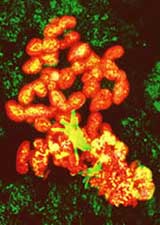Life, as it was in the beginning?

200 meters below Idaho, bacteria are living on basalt. <br>© SPL <br>
A new type of Earth ecosystem could be found on other planets.
Scientists have found a community of microbes unlike anything else on Earth. Conditions in this ecosystem could mimic those on Earth when life began, and might exist elsewhere in today’s Solar System.
Home to the microbes is a hot spring 200 metres beneath the US state of Idaho. Their lives owe nothing to the Sun. They generate energy by combining hydrogen from rocks with carbon dioxide, releasing methane as a by-product. These ’methanogens’ belong to an ancient group related to bacteria, called the Archaea.
While drilling into a hot spring where there is no organic carbon to feed more conventional life, Frank Chapelle of the US Geological Survey in Columbia, South Carolina, and his colleagues identified the microbes living there from their DNA sequences1.
They were shocked to find that more than 90% of the organisms in the spring were methane-producing Archaea. The technician “freaked out,” recalls Chapelle, assuming she’d made a dreadful mistake. In most places, such microbes make up only 2 or 3% of microbial life.
Life – in space and time
Biologists have speculated for many years that hydrogen-powered ecosystems could exist beneath the ground. The methanogen community suggests they were right, says astronomer and astrobiologist Richard Taylor of the Probability Research Group in London.
“As long as there’s subsurface water and enough chemical fuel, you can get microbial life,” says Taylor. He thinks that life began in such environments: “It’s life on the surface that’s unusual,” he says.
Many bodies in the Solar System and the Universe could harbour similar conditions. “I suspect it’s going to turn out that life is extremely common,” says Taylor.
Mars and Jupiter’s moon Europa have both been suggested as places where life could exist on hydrogen, today or in the past. If this is so, says microbiologist Julian Hiscox of the University of Reading, UK, it will be several kilometres below the surface, well beyond the reach of any investigations so far.
Probing these environments is going to cost “an awful lot of money”, warns Hiscox. A cheaper alternative, he says might be to look for biologically produced methane in martian meteorites on Earth.
Also, Hiscox says, the geological activity necessary to produce hydrogen may have stopped long ago on Mars, and be absent altogether on Europa.
The finding may give us an insight into life in time as well as space. Chapelle thinks that hydrogen may have been accessible and abundant enough on the young Earth to provide the energy for the earliest life.
References
- Chapelle, F. H. A hydrogen-based subsurface microbial community dominated by methanogens. Nature, 415, 312 – 315, (2002).
Media Contact
More Information:
http://www.nature.com/nsu/020114/020114-7.htmlAll latest news from the category: Life Sciences and Chemistry
Articles and reports from the Life Sciences and chemistry area deal with applied and basic research into modern biology, chemistry and human medicine.
Valuable information can be found on a range of life sciences fields including bacteriology, biochemistry, bionics, bioinformatics, biophysics, biotechnology, genetics, geobotany, human biology, marine biology, microbiology, molecular biology, cellular biology, zoology, bioinorganic chemistry, microchemistry and environmental chemistry.
Newest articles

A universal framework for spatial biology
SpatialData is a freely accessible tool to unify and integrate data from different omics technologies accounting for spatial information, which can provide holistic insights into health and disease. Biological processes…

How complex biological processes arise
A $20 million grant from the U.S. National Science Foundation (NSF) will support the establishment and operation of the National Synthesis Center for Emergence in the Molecular and Cellular Sciences (NCEMS) at…

Airborne single-photon lidar system achieves high-resolution 3D imaging
Compact, low-power system opens doors for photon-efficient drone and satellite-based environmental monitoring and mapping. Researchers have developed a compact and lightweight single-photon airborne lidar system that can acquire high-resolution 3D…





















